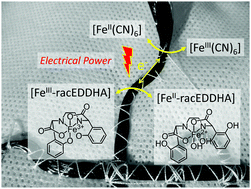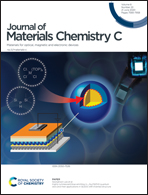Activation of carbon tow electrodes for use in iron aqueous redox systems for electrochemical applications†
Abstract
Excellent chemical inertness, good conductivity and high overpotentials for water electrolysis make carbon fibres (CFs) an ideal electrode material for electrochemical applications. A customized design of three-dimensional (3D) carbon electrodes can be achieved by tailored fibre placement of carbon tows with textile production techniques like embroidery. After manufacturing of the 3D structure, appropriate removal of the polymer coating and oxidative activation is required to achieve low overpotentials and avoid thermal treatments of the carbon structure. For the electrolytes Na[FeIII-racEDDHA] and K4[FeII(CN)6] a sequential treatment by acetone extraction and anodic oxidation was identified to yield optimum surface activation. Electron microscopy, Raman spectroscopy and X-ray photoelectron spectroscopy of activated fibres indicated complete removal of the coating layer without damage of the CFs. From electrochemical impedance spectroscopy (EIS) at the carbon tow electrodes, charge transfer resistances of <0.1 Ω (0.023 Ω g) and < 0.2 Ω (0.046 Ω g) were determined at 50% state-of-charge (SoC) for 65 mM K4[FeII(CN)6] and 65 mM Na[FeIII-racEDDHA], respectively. In potentiostatic bulk electrolysis no electrode deactivation was observed during 10 charge/discharge cycles (5–6 hours) between 10% and 90% SoC. The processing of carbon tows by textile techniques to near net shaped 3D electrodes opens a new method to manufacture electrodes for electrochemical applications, such as redox flow cells.



 Please wait while we load your content...
Please wait while we load your content...